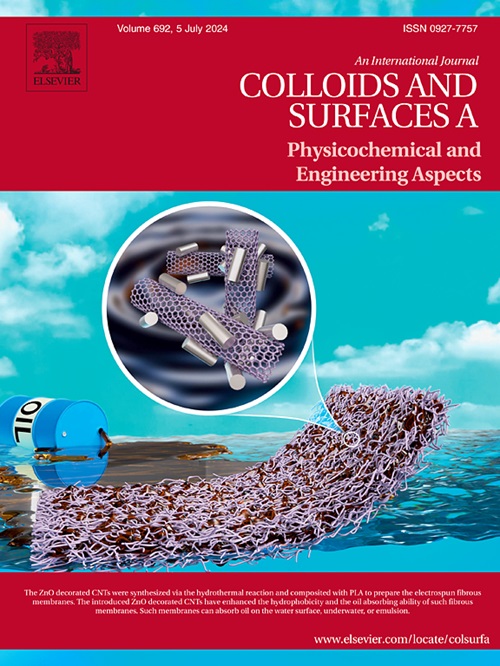Solar light induced tetracycline hydrochloride elimination over La2S3-CoIn2S4/NH2-functionalized polyacrylonitrile nanofibers
IF 5.4
2区 化学
Q2 CHEMISTRY, PHYSICAL
Colloids and Surfaces A: Physicochemical and Engineering Aspects
Pub Date : 2025-07-16
DOI:10.1016/j.colsurfa.2025.137738
引用次数: 0
Abstract
La2S3 and CoIn2S4 were in-situ grown on the surface of NH2-functionalized polyacrylonitrile (PAN) nanofibers to form Z-scheme La2S3-CoIn2S4/NH2-PAN heterojunction for boosting solar light driven photodegradation of tetracycline hydrochloride (TCH). Z-scheme junction between La2S3 and CoIn2S4 was favorable for facilitating the separation and migration of e-/h+ pairs, meanwhile S defects and -NH2 groups served as the vacant sites of TCH adsorption and photon capture. In addition, ·O2- was the vital radical for the conversion of TCH to the harmless species and small molecules. The adsorption-photocatalytic capacity of La2S3-CoIn2S4/NH2-PAN was greatly affected by La2S3 content, pH, and inorganic salts. La2S3-CoIn2S4/NH2-PAN nanofibers exhibited the better adsorption-photocatalytic activity than La2S3-CoIn2S4/PAN, La2S3/NH2-PAN, and CoIn2S4/NH2-PAN for TCH elimination. The removal efficiency of TCH over optimal 3-La2S3-CoIn2S4/PAN with a nominal La2S3 content of 16 wt% was 98.32 % within 120 min, while declined to 89.01 % after five cycles due to the change in the valance states of surface components and metal leaching under the long-time irradiation.
la2s3 - co2s4 / nh2功能化聚丙烯腈纳米纤维对盐酸四环素的去除作用
在nh2功能化聚丙烯腈(PAN)纳米纤维表面原位生长La2S3和CoIn2S4,形成Z-scheme La2S3-CoIn2S4/NH2-PAN异质结,促进太阳能光降解盐碱四环素(TCH)。La2S3和CoIn2S4之间的Z-scheme结有利于e-/h+对的分离和迁移,同时S缺陷和- nh2基团是TCH吸附和光子捕获的空穴。此外,·O2-是TCH转化为无害物质和小分子的重要自由基。La2S3- coin2s4 /NH2-PAN的吸附光催化性能受La2S3含量、pH和无机盐的影响较大。La2S3-CoIn2S4/NH2-PAN纳米纤维对TCH的吸附光催化活性优于La2S3-CoIn2S4/PAN、La2S3/NH2-PAN和CoIn2S4/NH2-PAN。在标称La2S3含量为16 wt%的最优3-La2S3-CoIn2S4/PAN上,在120 min内,TCH的去除率为98.32 %,而在5个循环后,由于长时间照射下表面组分价态的变化和金属浸出,TCH的去除率下降到89.01 %。
本文章由计算机程序翻译,如有差异,请以英文原文为准。
求助全文
约1分钟内获得全文
求助全文
来源期刊
CiteScore
8.70
自引率
9.60%
发文量
2421
审稿时长
56 days
期刊介绍:
Colloids and Surfaces A: Physicochemical and Engineering Aspects is an international journal devoted to the science underlying applications of colloids and interfacial phenomena.
The journal aims at publishing high quality research papers featuring new materials or new insights into the role of colloid and interface science in (for example) food, energy, minerals processing, pharmaceuticals or the environment.

 求助内容:
求助内容: 应助结果提醒方式:
应助结果提醒方式:


